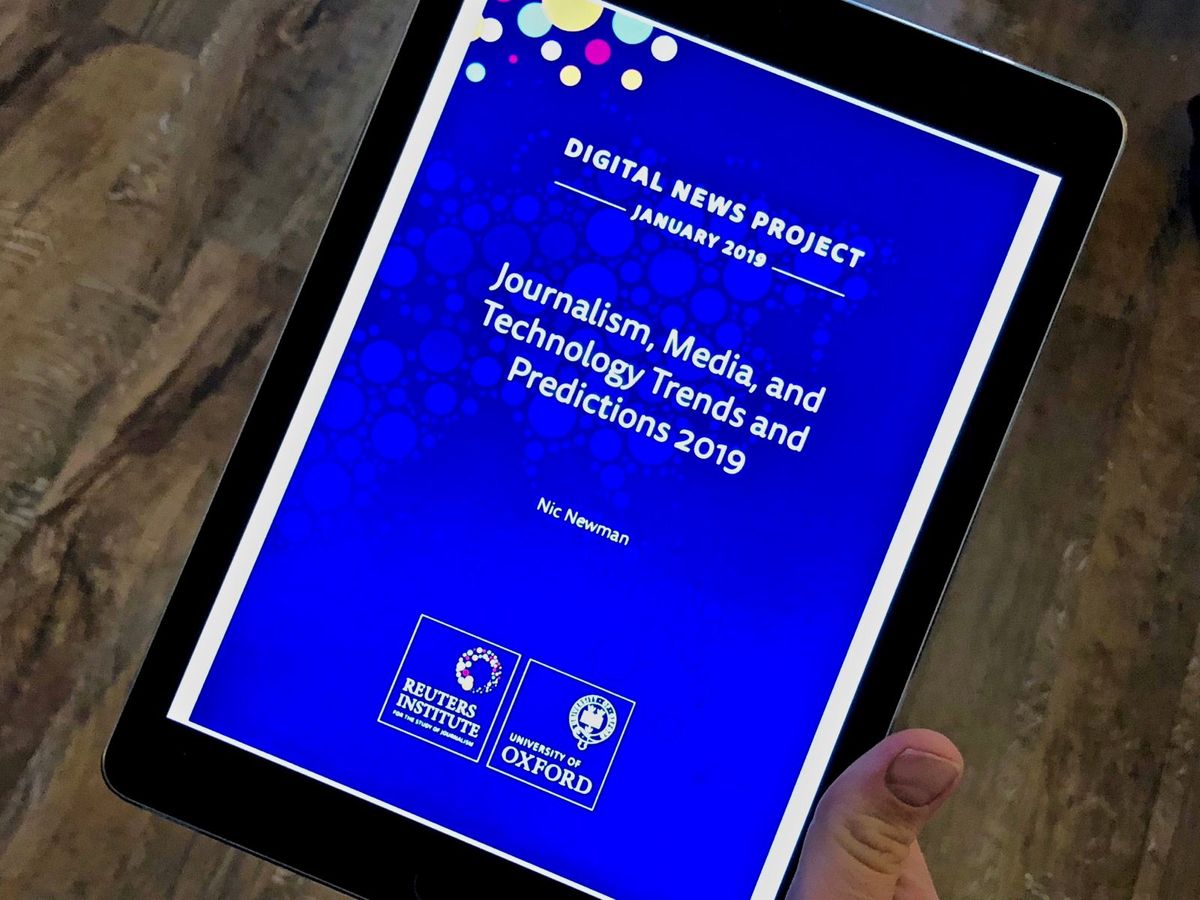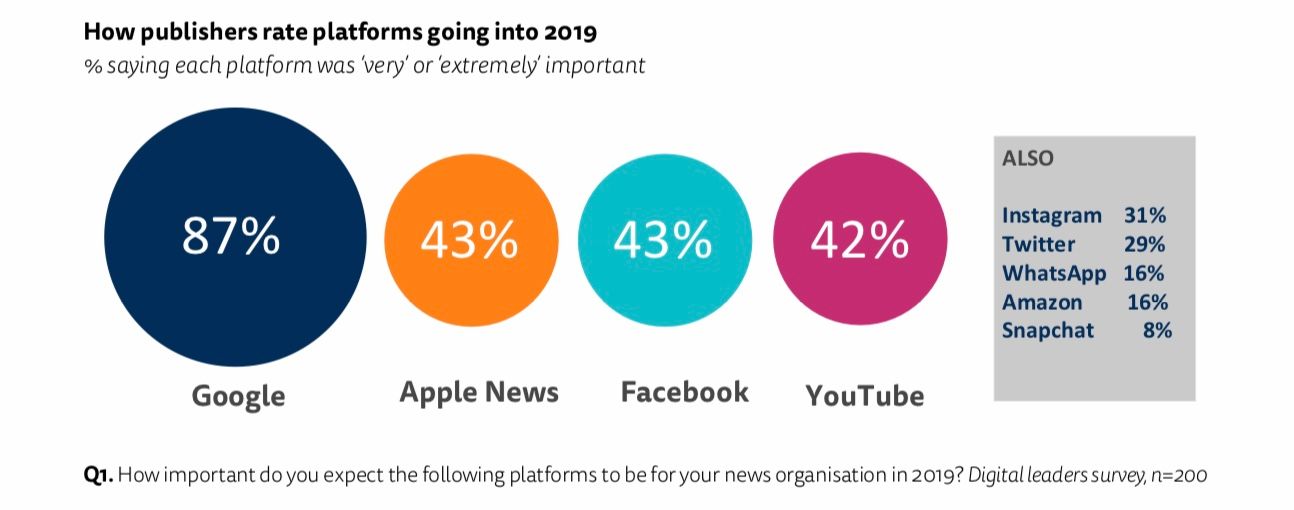Media Trends 2019: an earthquake in audience engagement, and openness to new business models
The 2019 edition of the Journalism, Media and Technology Trends and Predictions report finds an industry rethinking many of its assumptions about the way digital operates.

The latest edition of Nic Newman'a annual Journalism, Media and Technology Trends and Predictions report was released today, and it makes for fascinating reading.
It captures a moment in time where the industry as a whole is waking up to the fact that many of the solutions it thought were the way formward in digital media aren't going to be sustainable, and we need to try more radical appraches. In particular, the Facebook traffic collapse and the subsequent stumbing of many digital pure play titles has exposed the reality of the audience landscape for the first time in nearly a decade — and it's not pretty.
From the report, I get a sense that publishers are becoming aware that the answers to our problems are, well, complex. And that’s good. The quest for a single solution to our digital woes has led us down some dangerous alleys, from paywalls around undifferentiated content, to a dangerous over-reliance on Facebook.
Here’s some of my initial thoughts on the findings. I’ll save analysis of some of the findings around specific technologies — like audio or newsletters — for later posts.
The Audience Engagement earthquake
Without any doubt, 2018 was the year that the audience engagement landscape changed completely. For the past seven or eight years, Facebook had come to dominate the conversation to such a degree that many “social media” teams for newspapers were, in essence, Facebook post producers.
And then came the Facepocalypse earlier in the year, and a catastrophic drop in traffic across the industry. And that has opened people’s minds to new approaches to audience engagement. The new landscape is beautifully summed up by this figure:

Google — and, thus, SEO, is in the ascendency again. My latest SEO course sold out in record time, at such a rate that we’re hoping to have another one in the diary for the spring. People will always search for content, and so it remains a viable technique, one that was somewhat neglected at the height of the Facebook era.
It is interesting to see Apple News rating so highly. 18 months ago I was describing it as the biggest secret in audience development — it looks like the secret is out. With Apple likely to make some big move in this space post the acquisition of Texture, this is worth watching.
The one platform I’m surprised not see see represented at all is Flipboard - cross-publishers analytics have shown it on the rise as a traffic source although the experience of individual publishers has varied.
Platform skepticism on the rise
Probably the single most reassuring aspect of the report is this, though:
But there also appears to be a change in sentiment toward third party platforms in general. Many publishers have been burned by creating bespoke content only to find the goalposts changing or the monetisation slow to materialise.
Nic goes on to quote an (anonymous) UK publisher as saying that they are focused on using social to bring people back to the site:
“We aren’t interested in building communities on external platforms for the benefit of that platform."
This is exactly as it should be — and should have always been. Social media activity needs to be tied into the site’s business model in an intelligent way. And just spamming Facebook with links was never that. It will be interesting to see how long the current focus on Facebook groups lasts, especially now that Facebook have started making groups less prominent in your notifications, switching many groups to “highlights only”.
Social Media is still relevant for journalism
At least one UK newspaper has seen the social media role switch from being a journalistic one to a marketing one - and then back again. It should, I think, remain with editorial, because even as social media declines in relative importance as an acquisition method, it will continue to be an incredibly important journalist too, allowing the reporting of stories that might be hard to break otherwise. Nic highlights the BBC’s anatomy of a murder story as an example, but there are many others.
With luck, we’ll see social media move back to being a central investigative and verification role, rather than an essentially promotional one in the newsroom. Just bundling social media in with audience development means that essential journalistic side gets neglected in too many newsrooms. Sure, all journalists should have a baseline understanding of social media as a reporting tool, but there’s room for specialists who can dig deeper an verify deeper, too.
The danger, of course, is that social media gets too swept up in the techlash that’s underway, and people drop it rather than reassess their relationship with it. We shall see.
New skills needed for social media content
One trend I’m hearing very clearly from many working on social content is the need to refine workflows around how you balance creation for multiple streams. This is a big challenge for many newsrooms going into 2019.
Right. And I wonder if anyone has really cracked workflows for video and visual storytelling. How to create for IG and Snapchat Discover and AMP Stories and YouTube and Facebook video. Organise teams / output by story or by platform?
— Sarah Marshall (@SarahMarshall) January 9, 2019
However, as Nic points out, a more fundamental challenge might be acting that you need to have the right skills and those might look quite different from what we have associated with “serious” journalism in the past:
The ‘news feed’ is in many ways a hangover from the desktop era, whereas stories are made for mobile screens, demand more visual storytelling skills and rely heavily on the personality of the reporter.26 Publishers looking to attract younger audiences in particular will need to develop more of these skills in 2019.
And that might mean hiring different sorts of people.
The Faustian Pact
The one part of the report that makes me most nervous is the number of publishers looking to the tech platforms and governments for financial support. This runs the risk of being a Faustian pact that will cost publishers dearly. Subsidy by Government carries obvious editorial independence questions and costs, as the Russian and Chinese examples show, - but then, so does subsidy by tech platforms. Money rarely comes without strings, and platforms throwing money at us to avoid regularly oversight doesn’t feel a move that wold benefit anyone apart from the tech platforms.
As scrutiny of the tech platforms grows in the coming year — Google and Amazon have got off lightly so far — taking money from them will seem increasing at odds with a perception of editorial independence. Google is handling this well at the moment, largely funding intermediaries rather than publishers themselves.
Yes, things are bad out there, and yes, the duopoly have sucked away money that used to flow into publishers’ pockets — but throw away what trust we have left and we’ll be in even direr straights.
Enter the Triopoly
Talking of Amazon and the duopoly, Nic suggests that we’re entering the world of the Triopoly, with Amazon joining Facebook and Google as a major force within the ad market:
Research group eMarketer finds that consumers are increasingly starting product searches on Amazon rather than Google, enabling it to charge higher premiums. Overall Amazon has taken 4% of online ad spending in the US, a figure that is expected to rise to 7% by 2020.
Another example of competition in digital coming from unexpected places. And that push on ad revenue leads us to this…
The Business Model: Reader Revenue
Another big number: 59% of publishers have some form of reader revenue as their main revenue focus for the year:
- 52% are focusing on subscriptions
- 7% are focusing on donations (the Guardian model).
81% still see display revenue as an important source of income, but this shows a really strong desire to diversify away from the ad-based model, born, I suspect, out of necessity.
I talked quite a lot about this in my contributions to Nic when he was researching the report. Here’s what I said:
We’ll start to encounter the limits of the membership model, I suspect. I’m not sure we’re past the “single magic fix” era of thinking yet, and memberships are likely to be where people flee next. But some of them are going to fail. Clearly, there’s a ceiling on how many subscriptions or memberships people are going to pay for, and as more titles adopt it, we’ll see those limits kicking in. I suspect that the more generalist sites will find it harder going, and the Buzzfeed experiment will be an interesting one for that very reason. Even The Correspondent will be fascinating to watch in a much more crowded marketplace than its original market.
Making memberships and paywalls work requires a fanatical focus on delivering reader value, so they feel like re-upping their subscriptions, coupled with a great audience acquisition strategy. These are really hard to balance, and the industry really isn’t good yet at asking hard questions about the value of what they’re producing. There are signs that’s changing - I’ve had more conversations around the ‘are we producing too much content?’ question than ever before, which is a step in the right direction.
I think the rest of Nic’s research supports that. In essence, making reader revenue work isn’t as simple as throwing up a paywall of some sort and calling it job done, it’s a hard process of evaluating the value of what you’re producing and its effectiveness at attracting or retaining those customers.
As Rasmus Kleis Nielsen from the Reuters Institute put it in his recent piece for Neiman Lab:
Much of the news currently published online is simply not worth paying for. Some of it is hardly worth our fleeting attention, let alone hard-earned cash.
The Sun’s failed paywall is a lesson in the dangers of trying to charge for largely undifferentiated content.
The Curious Absence of Analytics
I was surprised by the relative paucity of mentions of analytics as a result of this — use of analytics a critical part of making that journey, and it you try to do it without them, you really are navigating without a map. However, one interesting example did pop up:
The Financial Times has created a dashboard that monitors the reading habits of existing female subscribers to encourage editors to create more content that might appeal to women. But deeper research on gender preferences has also led to new products such as the Long Story Short newsletter, five stories you shouldn’t miss, curated by a female FT journalist. One unexpected by-product was that this newsletter also proved a hit with disengaged male readers.
This is fascinating to me, because five years ago when I did a chunk of workshops for the FT with Neil Perkin, there was a lot of nervousness around using analytics in the newsroom. Now, they’re moving to the forefront of the title using the intelligently for content planning and development.
There's plenty more in the report I'd like to address, but given that this is already over 1,800 words, this is probably a good time to stop. In the meantime, grab yourself a copy of the full report:
Download Journalism, Media, and Technology Trends and Predictions 2019.





